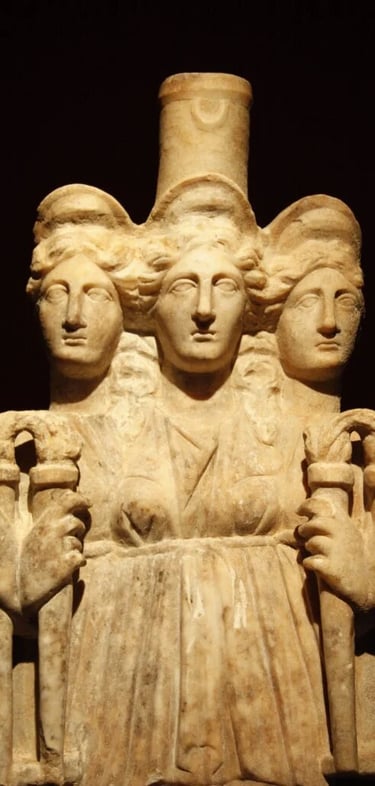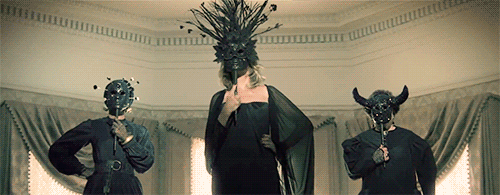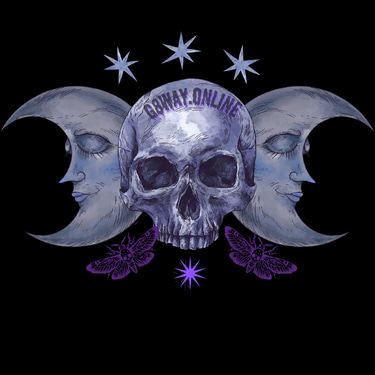Hecate. An Unnecessary Centerpiece Albeit A Nice Prop!
Debunking dissecting and disproving the hype around Hecate, the Triple Moon Goddess, often referred to in witchcraft. Further explanation as to why necromancers should steer clear of worshiping and / or implementing the use of anything other than their own capabilities. True empowerment lies in self-reliance .
POLYTHEISMTRIPLE MOON GODDESSHECATEDIANAROMANARTEMISGREEKHELLAS
Illya Burke
4/12/20226 min read


The origins of Hecate in relation to the archetypes of Maiden, Mother, and Crone, illustrate her multifaceted role in the lives of witches throughout history and the demographic of those who invoke her presence today. However, in this modern fixation on the darker aspects of the divine, many have overlooked the broader pantheon of the Hellenic gods—whose stories, virtues, and realms shaped the ancient world. Instead of turning to later Roman adaptations or reducing deities like Hecate to narrowly defined shadow figures, persons should return directly to the wellspring of Western myth: the ancient Greek deities themselves. The gods and goddesses of Hellas were not merely symbols of power or mystery; they embodied the full spectrum of human experience—love, wisdom, music, justice, and even booze.
To fixate solely on the obscure and the somber, while dismissing the original wonderment and luminous diversity of these divine figures, is not only reductive but deeply disrespectful to the spiritual legacy of a civilization that once found the sacred in everything from sunlight to sea foam. So, Hecate's attributes and representations have evolved significantly from her early origins to modern interpretations. The origins of Hecate in relation to the archetypes of Maiden, Mother, and Crone, illustrate her role in the lives of witches throughout history and the demographic of those who invoke her presence today without much regard for anything else. A red flag sign of ignorance at its best.
Historical Context of Hecate
Initially depicted as a goddess of magic and the night, (the moon got thrown into the scene as witches preferred to congregate at night, deep in the woods, away from witch hunters and idiots) Hecate’s significance solidified during the Hellenistic period, where she was revered as a powerful figure in both the underworld and the celestial realm. As noted in research from Illinois State University, Hecate's role as a protector and guide for souls in transition carved her niche not just among deities but as a symbol of feminine power. The mama. The connection to the moon also helps align her with cycles of life, offering an essential bridge to the trifold nature of women represented by the Maiden, Mother, and Crone.
The archetypes of Maiden, Mother, and Crone symbolize the stages of a woman's life, each carrying unique attributes and powers. In many traditions, these figures embody the cyclical nature of existence — birth, nurture, and wisdom. Hecate embodies these aspects through her mythological narratives:
🔮 Maiden: Representing new beginnings, development and potential. Hecate, in her earliest iterations, symbolizes the strength of youth, exploration and the probability of growth.
*Con: Not very one has the same upbringing. This notion is true only if the parents practice witchcraft and implement it from birth. Modern day witches don't come into their own until their 20s at least. Up until then, It's open season complete with fumbles and triumphs. It’s fair to note that this is the case with all young people, so I don't see the significance.
🔮 Mother: The nurturing aspect of Hecate demonstrates her protective qualities, guiding individuals through life's challenges, akin to a maternal figure overseeing her children.
*Con: Not all women are mothers and some just don't have what it takes to be nurturing at all. Seriously. They'll forget to water a plant and others will (in essence) train their offspring to be anything but productive.
🔮 Crone: Hecate is often associated with death and the afterlife, embodying wisdom accumulated through experience. This aspect acknowledges the natural cycles of life and death and promotes acceptance of transformation.
*Con: wisdom comes with age regardless of gender — and even that's debatable. Ever heard of the saying "Ain’t no fool, like an old fool'? Welp, there's the hard-headed, stubborn instances like those types and then there's the unfortunate occurrence of cognitive decline in others. (At least, that's the elderly we have nowadays no doubt the result of being medicated and exposed to cancers turning bodies and brains into pus and mush)
Modern Usage and Demographics of Witches Utilizing Hecate continues to serve as a powerful symbol for many practitioners of witchcraft and neo-paganism. I suppose this concept (if believed wholeheartedly) would make one feel like they're getting through to something grand, but power always comes from within, as all real, actual witches know all too well. But still some followers labeling themselves as witches across varying demographics invoke the idea of Hecate for her proposed protective qualities and fanciful connection to the lunar cycles.
Recent trends show that contemporary practitioners often identify with feminist spirituality, seeking a reclamation of divine feminine power. According to the research referenced, Hecate is particularly popular among younger, impressionable witches, as well as those who align with eco-feminism and the idea of interconnectedness with nature. (Hippies aka Wiccans, no offense lol) True, enough bonfires were and still to this day used in ritual and plenty of us still do engage dancing with it, Wiccan or not. Anyway, this demographic is characterized by a strong online presence, participating in communities that embrace traditional practices blended with modern perspectives, i.e., their being told and molded to incorporate this ideal into their practice. Perhaps it's always been a ploy to weaken us? Hmph.
Conclusion
Hecate's significance as the moon goddess and her correlations with the Maiden, Mother, and Crone archetypes emphasize her timeless relevance in witchcraft. But not a necessary one. The ongoing use of Hecate among modern practitioners illustrates a powerful reclamation of feminine power and spiritual agency. As societies continue to evolve, so does the understanding and integration of Hecate, making her a solid figure in both the historical context of witchcraft and contemporary practices. Through this study, we can appreciate how Hecate not only shapes individual experiences but also influences broader cultural narratives surrounding witchcraft today, even if only by way of visual allure.
This exploration into Hecate's origins and contemporary applications underscores her enduring legacy as a powerful symbol backed by the essence that is: Diana! Polytheistic energies derived from a time older than the mortal form. Perhaps, practitioners and novices should cut out the middleman here and completely turn their attention to Paganism instead.
The earliest known mention of Hecate dates back to 2AD linking her to the Religio Romana deity Diana. Paganism predated Christianity and continues to be the foundational construct of most Neopagan branches. In accordance with Dianas force and meanings having strong bearing in the outcome of many rituals. Green sorcery often misuses Hecate because of the false interpretations of Hecates link to Diana and her abilities! (Understanding the relevance is imperative, citing Artimis, Greek predecessor and equivalent of Diana.)
When most people think of the divine feminine in witchcraft, their minds immediately drift to the Triple Moon Goddess—Maiden, Mother, and Crone—often associated with Hecate, the Greek goddess of magic, crossroads, and the liminal. And while her archetypal significance is undeniable and beautiful in its cyclical representation of life’s stages, it’s vital to remember that the idea of witches existing in threes is far older, broader, and not solely tethered to any one deity.
It’s no accident that trios are often seen delivering fate, knowledge, or doom—they are mirrors of life’s complexity, not bound by linear thinking but cyclical understanding. Whether evoking Hecate, nodding to Macbeth’s prophetic sisters, or watching Ebenezer Scrooge dream, witches serve as agents of transformation, truth, and disruption. And they don’t always wear the face of the Triple Moon.
So why three witches? And what’s the deeper purpose of a witch in the first place? Witches, at their core, are threshold figures—boundary walkers who operate between worlds, truths, and possibilities. The number three has long been seen as a magical constant in storytelling and spirituality, forming a balanced structure for power, perspective, and prophecy.
The image of a trio of witches reaches deep into cultural, mythological, and theatrical roots—appearing in the form of the Moirai (Greek Fates), the Norns of Norse myth, and famously in Shakespeare’s Macbeth as the “Weird Sisters.” Their nature is a symbolic device: one that transcends gender, religion, or singular pantheons, and speaks to something universal—past, present, future; birth, death, rebirth; intention, action, result; aka cause and effect. Even up until today, we're witnessing interpretations through screenwriters and playwrights; birthing images from desciptions and bringing concepts to life.



Eclectic Occultist
G8WAY intellectual property found herein is branded as such and most graphic interchange formats along with all links lead to external businesses not owned or operated by G8WAY. If you own any image included here and wish to request its removal or proper attribution, please contact admin@g8way.online and G8WAY will respond promptly. Please note: a page’s presence in G8WAY does not imply it is complete. Each entry is a living document that may be subjected to editorial corrections and/or additions. G8WAY may earn a commission when users make a purchase through links posted throughout this site. Information on WWW.G8WAY.ONLINE is for informational purposes only and should not be considered professional advice. Thank You for Visiting! G8WAY.ONLINE ©2025 All rights reserved.
